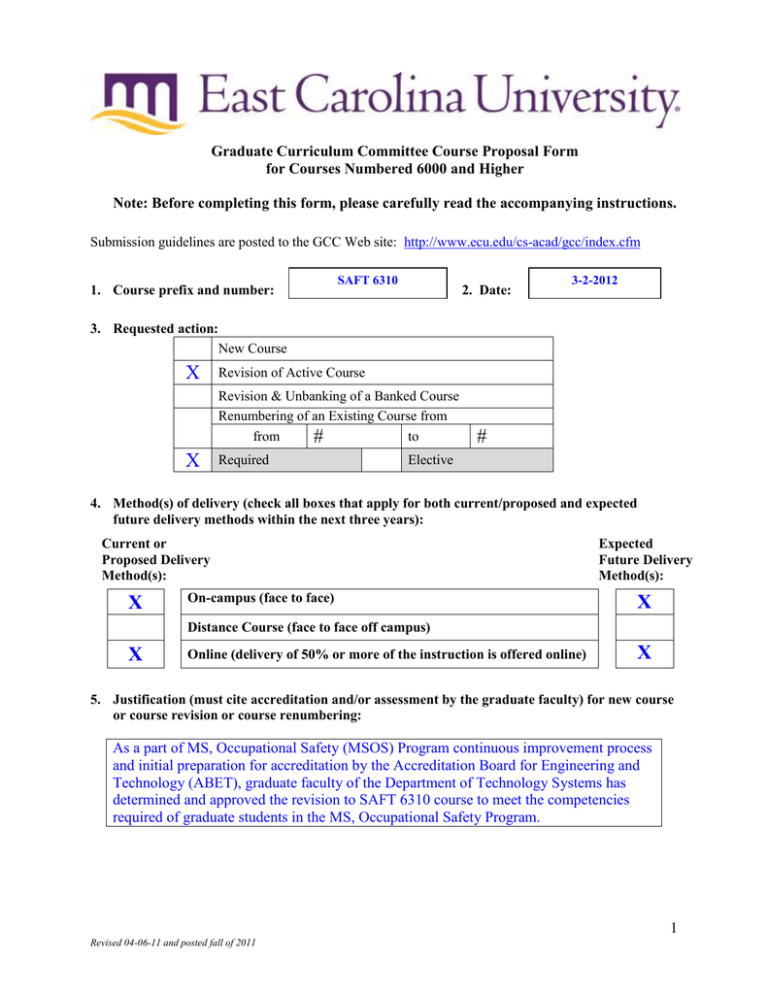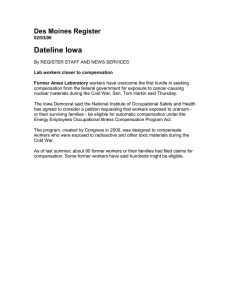Document 15476419
advertisement

Graduate Curriculum Committee Course Proposal Form for Courses Numbered 6000 and Higher Note: Before completing this form, please carefully read the accompanying instructions. Submission guidelines are posted to the GCC Web site: http://www.ecu.edu/cs-acad/gcc/index.cfm 1. Course prefix and number: SAFT 6310 2. Date: 3-2-2012 2. 3. Requested action: New Course X Revision of Active Course Revision & Unbanking of a Banked Course Renumbering of an Existing Course from from to # X Required # Elective 4. Method(s) of delivery (check all boxes that apply for both current/proposed and expected future delivery methods within the next three years): Current or Proposed Delivery Method(s): X On-campus (face to face) Expected Future Delivery Method(s): X Distance Course (face to face off campus) X Online (delivery of 50% or more of the instruction is offered online) X 5. Justification (must cite accreditation and/or assessment by the graduate faculty) for new course or course revision or course renumbering: As a part of MS, Occupational Safety (MSOS) Program continuous improvement process and initial preparation for accreditation by the Accreditation Board for Engineering and Technology (ABET), graduate faculty of the Department of Technology Systems has determined and approved the revision to SAFT 6310 course to meet the competencies required of graduate students in the MS, Occupational Safety Program. 1 Revised 04-06-11 and posted fall of 2011 6. Course description exactly as it should appear in the next catalog: 6310. Risk Management and Workers’ Compensation (3) P/C: SAFT 6001, 6040; or consent of instructor. Study of risk management strategies in reducing corporate financial losses due to accidents and injuries. Overview of insurance, commercial general liability, and workers’ compensation cost containment process. 7. If this is a course revision, briefly describe the requested change: Adding Risk Management to the course title and expanding competencies. 8. Course credit: Lecture Hours 3 3 Weekly OR Per Term Credit Hours Lab Weekly OR Per Term Credit Hours s.h. Studio Weekly OR Per Term Credit Hours s.h. Practicum Weekly OR Per Term Credit Hours s.h. Internship Weekly OR Per Term Credit Hours s.h. Other (e.g., independent study) Please explain. s.h. s.h. 3 Total Credit Hours s.h. 15 9. Anticipated annual student enrollment: 10. Changes in degree hours of your programs: Degree(s)/Program(s) Changes in Degree Hours MSOS Program None 11. Affected degrees or academic programs, other than your programs: Degree(s)/Program(s) Changes in Degree Hours None None 12. Overlapping or duplication with affected units or programs: X Not applicable Documentation of notification to the affected academic degree programs is attached. 13. Council for Teacher Education (CTE) approval (for courses affecting teacher education): X Not applicable Applicable and CTE has given their approval. 14. University Service-Learning Committee (USLC) approval: X Not applicable Applicable and USLC has given their approval. 2 Revised 04-06-11 and posted fall of 2011 15. Statements of support: a. Staff Current staff is adequate X Additional staff is needed (describe needs in the box below): b. Facilities X Current facilities are adequate Additional facilities are needed (describe needs in the box below): c. Library X Initial library resources are adequate Initial resources are needed (in the box below, give a brief explanation and an estimate for the cost of acquisition of required initial resources): d. Unit computer resources X Unit computer resources are adequate Additional unit computer resources are needed (in the box below, give a brief explanation and an estimate for the cost of acquisition): e. ITCS resources X ITCS resources are not needed The following ITCS resources are needed (put a check beside each need): Mainframe computer system Statistical services Network connections Computer lab for students Software Approval from the Director of ITCS attached 16. Course information (see: Graduate Curriculum and Program Development Manual for instructions): a. Textbook(s) and/or readings: author(s), name, publication date, publisher, and city/state/country. Include ISBN (when applicable). Text Moore, S.D. (2009). Understanding Workers’ Compensation Insurance, Clifton Park, NY: Delmar. ISBN 1-4180-7270-2 Optional: Malecki, Donald S., Horn, R.C., Wiening, E.A., Flitner, A.L., (2008). Commercial Liability Insurance and Risk Management (7th ed.), Volume I. AICPCU. ISBN 0894633600 Malecki, Donald S., Horn, R.C., Wiening, E.A., Donaldson, J.H., Flitner, A., L., (2001). Commercial Liability Insurance and Risk Management (5th ed.), Volume I. AICPCU. ISBN 0894630997 Readings from selected literature 3 Revised 04-06-11 and posted fall of 2011 b. Course objectives for the course (student – centered, behavioral focus) Upon completion of this course, students will be able to: Analyze and select commercial general liability coverage Apply concept of risk management and its applications in occupational and environmental settings; Analyze and interpret workers’ compensation loss run reports; Perform a workers’ compensation process assessment; Develop and implement loss prevention programs in occupational settings; Develop comprehensive workers’ compensation cost containment programs in occupational settings. c. Course topic outline Topics Covered: 1) An overview of Risk Management and Insurance concepts and history of Workers’ Compensation; 2) Commercial General Liability Coverage A, B, and C and the Exclusions; 3) Workers’ Compensation: Legislative law in many states; 4) Workers’ Compensation premium rating process; 5) Claims Management process and Case Management process and their financial impacts on bottom line; 6) Labor organizations and workers’ compensation process; 7) Medical community and workers’ compensation; 8) Legal issues with workers’ compensation and managing litigation process; 9) Transitional return to work process and its financial impacts on bottom line; 10) Professional and ethical responsibility as an EHS practitioner managing workers’ compensation process; 11) Interaction with injured employees and their families as well as government agencies, legal community, insurance companies, labor organizations, and other entities involved in the workers’ compensation system; 12) Study of workers' compensation and occupational safety in preventing corporate financial losses. 4 Revised 04-06-11 and posted fall of 2011 d. List of course assignments, weighting of each assignment, and grading/evaluation system for determining a grade Assignments: Quizzes................................................................. 30% Interview/Guest Speakers Reports ....................... 30% Workers’ Compensation Legal Case Study ......... 10% Research Paper ..................................................... 30% Grading: 100%-90% .................. A 89.9%-80% ................. B 79.9%-70% ................. C 69.9%-0 ....................... F 5 Revised 04-06-11 and posted fall of 2011


